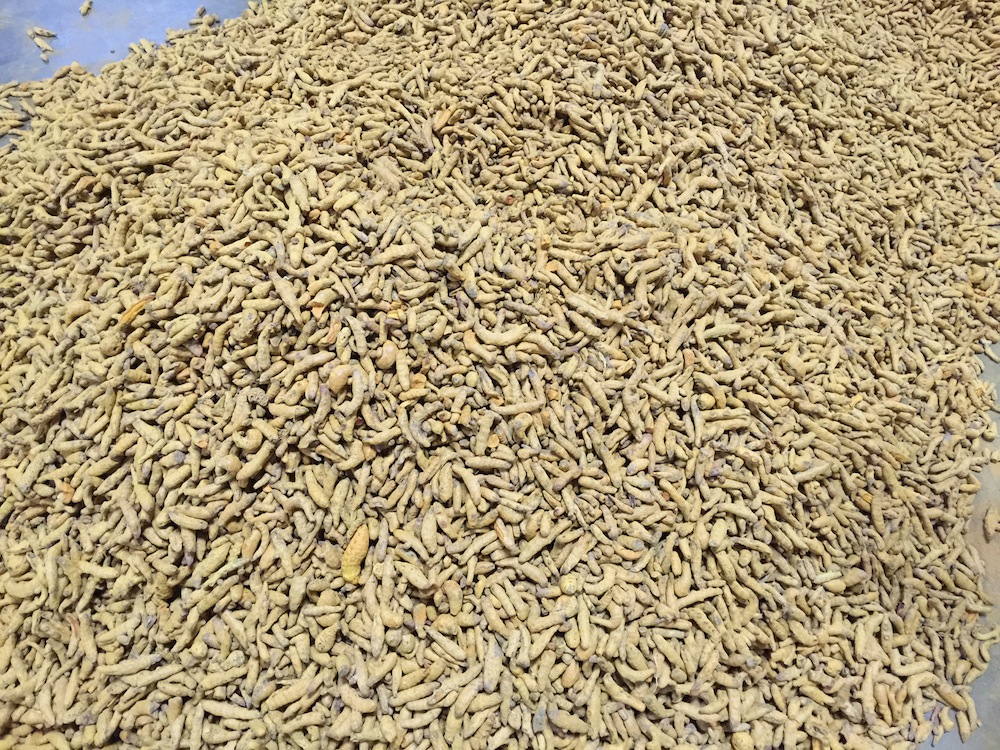Our latest visit to Turmeric factories in India proved to be eye-opening. We decided to take a trip into some other factories, to see how the competition fared (under the guise of being potential customers) and also to genuinely see how certain turmeric could be priced so much cheaper than our own! Below are images compiled from 3 different ones in Western India. For their own integrity and privacy, we cannot be more specific the factory names or addresses.
Entering the factories

The first thing our eyes were greeted with at Factory number 2. It was raining, ground muddy, raw wood in contact with finished goods (home to insects and an absolute NO in any of our facilities)… but finished goods happily being loaded onto an open truck in bales. For those unfamiliar with bales, water and anything else can easily seep through the cracks. These bales were loaded with turmeric fingers. The fingers are past the drying, cleaning and polishing stages, just powdering left. They won’t be cleaned again before powdering – they can’t be further cleaned at this point besides expensive manual brushing over.

Still at Factory number 2: No hygienic clean shoes for us to change into, no lab clothing to enter the manufacturing or cleaning facility, and turmeric EVERYWHERE. Mixed in with dirt, rain, who knows what else. Did you catch the bales in the corner of the picture? Those are ready for shipment, and waiting to be loaded onto a truck.
The turmeric factories equipment
Part of Factory number 1: above is the machine for “polishing” turmeric. Turmeric in it’s raw dried form isn’t very appetizing to look at, and always has some dark exterior skin leftover from the drying process. By polishing this, the darker skin can be removed off resulting in a more tasty spice and better colour. But what scared us here is how old the machines were, and the fact that they probably hadn’t been cleaned out in months, maybe longer! Turmeric is a very seasonal product, and the season began just in February! Which means these machines should be looking far cleaner and in shape than they currently were.
Moving on…

At factory number 2: this is the machine for sifting turmeric once it’s been ground. Some pieces don’t get fully ground and remain a little course. Some rubbish also gets caught in the netting. This process removes those pieces. Yet again, like with the polishing machine, this one also looks much in need of a face lift. Exposed sharp metals (certainly not stainless steel), with visible rust. The sifter also includes certain netting and cloth, we don’t want to know when this was cleaned. Finally – what happens to the “rejected pieces”. there were several hundred kilos when we checked. Our guess? Back into the grinder to cover it up.
The raw turmeric material used

This raw material was not bad – just not polished, which is understandable. The telltale thing we noticed though is that it wasn’t just 1 variety of turmeric. There were at least 3-4 different things in here. Some of which produce dark red powder (very cheap goods), some of which product very light lemon yellow powder (also cheap because nearly no flavour but lot of colour). Then there were a mix of turmeric bulbs and halves and anything else – probably rejects from another lot?
Concluding thoughts
Not everything was bad! We checked the turmeric powder produced at the end too, and from a colour and aroma perspective, it was OK. We were told that the powder we were checking used a 30 – 50 – 20 mix of various turmerics (the 20% mix one is the most expensive and provides the best flavour. The other 2 make the final product cheaper in cost by around 30-35%, while maintaining colour!). We compared this along with our own sample to see very little different colour wise. The aroma was certainly much weaker though.
All in all, we hope this gave you an insight into turmeric production, and also a behind the scenes look at some unscrupulous ways certain factories use to keep costs low while keeping their output acceptable. This isn’t true for all of them, but is true for the majority of cheaper manufacturers.
None of these factories we checked had any ISO, HACCP or modern quality system in place. All of these factories’ goods get exported worldwide.
Want to know more about turmeric? Check out our Turmeric page for a brief history, our quality grades and the market price.